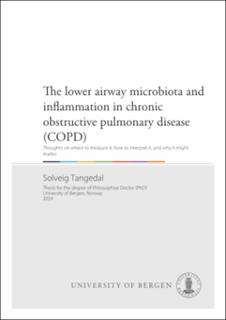The lower airway microbiota and inflammation in chronic obstructive pulmonary disease (COPD) : Thoughts on where to measure it, how to interpret it, and why it might matter
Doctoral thesis
Permanent lenke
https://hdl.handle.net/11250/3112852Utgivelsesdato
2024-02-01Metadata
Vis full innførselSamlinger
Sammendrag
Bakgrunn: Kronisk obstruktiv lungesjukdom (KOLS) er ein kompleks, inflammatorisk sjukdom som forårsakar millionar av dødsfall årleg. Bakteriane i dei nedre luftvegane (mikrobiotaet) og immunresponsar kan spele ei viktig rolle i KOLS. Målingar av dei begge kan tenkast å vera påverka av prøvetakingsmetode. Måla med denne oppgåva var å studere KOLS-kohortar med tanke på 1) høve for vekselbruk av indusert og spontant sputum for målingar av inflammasjonsmarkørar og mikrobiota, 2) endringar i inflammasjonsmarkørar og mikrobiota under sjukdomsforverringar samanlikna med stabil sjukdomsfase og 3) forskjellar i mikrobiota i bronkialskyllevæske (BAL) frå pasientar med KOLS samanlikna med friske kontrollar.
Metode: Sputum data kjem frå studiane BergenKOLS og tilhøyrande eksaserbasjonsstudie med 433 pasientar med KOLS inkludert, og 356 som vart følgt med tanke på forverringar. BAL data kjem frå studien MikroKOLS med 130 pasientar med KOLS og 103 friske kontrollar inkludert. Inflammasjonsmarkørar i sputum vart målt med bead based multiplex immunoassay og antimikrobielle peptid med enzyme linked immunosorbent assay. DNA sekvensar vart reinska ved hjelp av både enzym og mekanisk lysering. PCR-amplifisering av 16S rRNA og paired-end sequencing med Illumina MiSeq System vart utført. Data vart analysert i QIIME 1&2, Stata og R.
Resultat: Inflammasjonsmarkørar og mikrobiota var signifikant forskjellige i indusert og spontant sputum, og i stabil fase av KOLS samanlikna med under pågåande forverring. I høve til sjukdomsfase var ulikskapane heterogene når ein såg på kvart individ. Mikrobiota i BAL var meir ujamn og rikare på Firmicutes hos pasientar med KOLS samanlikna med friske. Kjønn, alder, røyking, sjukdomsgrad og bruk av inhalasjons-kortikosteroider var ikkje tydeleg assosiert til mikrobiotaet i dei nedre luftvegane.
Konklusjon: Sputumprøvetaking påverkar målingar av inflammasjonsmarkørar og mikrobiota. KOLS forverringar og KOLS i seg sjølv er begge assosiert med endringar i luftvegsmikrobiotaet. Det tyder på at mikrobiotaet spelar ei rolle i KOLS. Background: Chronic obstructive pulmonary disease (COPD) is a complex inflammatory disease causing the death of millions annually. The lower airway bacterial community (microbiota) and immune responses could be important for the pathogenesis of COPD. The aims for this thesis were to study COPD cohorts considering if measures of inflammatory markers and microbiota 1) are affected by sputum sampling techniques, 2) differ with COPD state, and 3) if the microbiota differ in bronchoalveolar lavage (BAL) comparing patients with COPD with controls.
Methods: Sputum data originated from the Bergen COPD Cohort and exacerbations studies in which 433 patients with COPD were enrolled and 356 followed for exacerbations. BAL data originated from the MicroCOPD study in which 130 patients with COPD and 103 controls were enrolled. Inflammatory markers in sputum were measured by a bead based multiplex immunoassay and antimicrobial peptides by enzyme linked immunosorbent assay. DNA sequences were obtained by enzymatic and mechanical lysis extraction methods, PCR-amplification of the 16S rRNA gene and paired-end sequencing using the Illumina MiSeq System. Data were analysed in QIIME 1&2, Stata, and R.
Results: Inflammatory markers and microbiota differed significantly between induced and spontaneous sputum, and between stable state COPD and exacerbations. Differences related to disease state showed great heterogeneity looking at individual participants. The microbiota in BAL sampled in the COPD cohort had lower evenness and higher abundances of Firmicutes compared with controls. Sex, age, smoking, disease severity and use of inhaled corticosteroids were not clearly associated with the lower airway microbiota.
Conclusion: Sputum sampling methods influences on measurements of inflammation and microbiota. Exacerbations in COPD and the presence of disease are both associated with microbiota dysbiosis which indicate importance of the lower airway microbiota in the pathogenesis in COPD.
Består av
Paper I: Tangedal S, Aanerud M, Persson LJ, Brokstad KA, Bakke PS, Eagan TM (2014): Comparison of inflammatory markers in induced and spontaneous sputum in a cohort of COPD patients. Respir Res. 15:138. The article is available at: https://hdl.handle.net/1956/10572Paper II: Tangedal S, Aanerud M, Gronseth R, Drengenes C, Wiker HG, Bakke PS, Eagan TM (2017): Comparing microbiota profiles in induced and spontaneous sputum samples in COPD patients. Respir Res. 18:164. The article is available at: https://hdl.handle.net/1956/18017
Paper III: Tangedal S, Nielsen R, Aanerud M, Persson LJ, Wiker HG, Bakke PS, Hiemstra PS, Eagan TM (2019) Sputum microbiota and inflammation at stable state and during exacerbations in a cohort of chronic obstructive pulmonary disease (COPD) patients. PLoS One.14(9):e0222449. The article is available at: https://hdl.handle.net/1956/22571
Paper IV: Tangedal S, Nielsen R, Aanerud M, Drengenes C, Husebø G, Lehmann S, Knudsen K, Hiemstra PS, Eagan TM (2024) The lower airway microbiota in COPD and healthy controls. Thorax. Not available in BORA. The article is available at: https://doi.org/10.1136/thorax-2023-220455.

